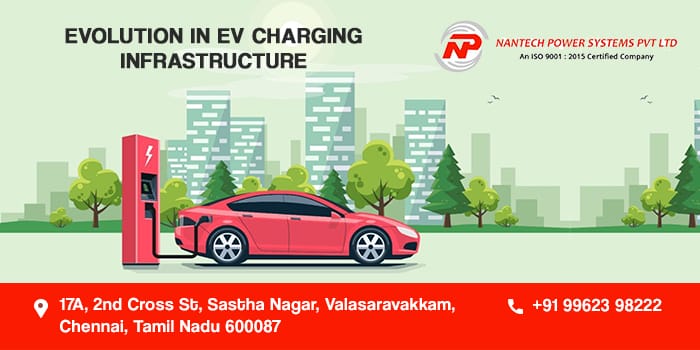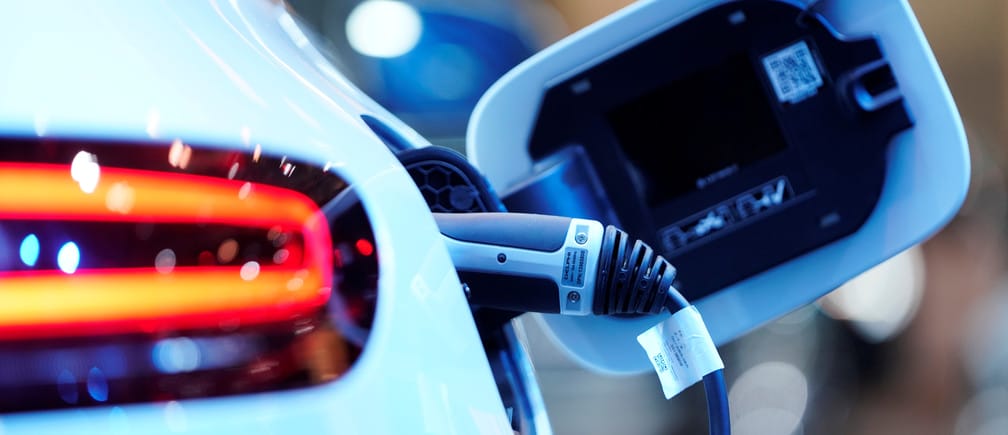- Home
- About us
- Products
- Dealer Enquiry
- Contact Us
- 044 -2486 1994
- +91 99623 98222
- sales@nantech.in
- REQUEST A QUOTE

Reducing carbon emissions is going to be one of the major focuses of the government. To strengthen the effort, the Government of India has taken initiatives to increase the possibility of E-Mobility. Companies are now focusing on developing electric vehicles and the development of charging stations plays a major role in the widespread growth of EVs. As per a study, India will have around 8 million public charging facilities and 79 million electric vehicles plying on the roads by 2030. As the leading EV charging solutions in Chennai, Nantech Power Systems commits to producing sustainable and reliable premium, public, commercial, and residential comprehensive EV charging stations.
Also Read: The EV Revolution: Is Chennai Ready For It?
The transport sector accounts for 40% of total fuel consumption and in this, 90% is used for road transport. The state and central governments are now adopting slow regulations and policies to promote the use of EVs. Lack of public charging facilities is a major hurdle the EV industry faces while convincing prospective buyers. Most of the charging takes place either at work or at home. Electric vehicle charging infrastructure or EVCI needs to be increased as getting stranded with empty batteries. Successful transition to e-mobility requires affordable, accessible, and reliable EVCI.
The government has followed international standards in developing an Indian specific standard called Bharat Charging. For the successful adoption of E-Mobility, the government has been adopting new regulations, incentives, and taxation policies. They must also take care of consumer education measures. Such initiatives are required to boost consumer confidence and increase partnership in developing electric vehicle charging infrastructure. Developing charging stations is a major challenge which the government will be taking initiative along with major players in the field.
There are different types of charging infrastructure which is renewable charging hubs, charging stations in communities and charging stations in office sites. Developing such a charging infrastructure is indispensable to eliminate barriers in adopting EVs. EV solution providers can set up charging infrastructure on a company's campus for its employees or they can tie up with real estate developers to set up charging stations within their properties. The Government of India has drafted a plan to set up 2636 EV charging stations in 62 cities, including Chennai, across all states and union territories by 2023. The decision has inspired many private and state-owned power utilities industries to enter the business of improving charging infrastructure.
Agreements are being signed with battery manufacturing companies and swapping companies to initiate infrastructure development. There is a need to maintain a balance between demand and supply and innovative and meaningful collaboration with key stakeholders will help in a long way. A demand aggregation model is devised to create a boom in the market to increase mobility services and charging infrastructure. The different demand aggregation models are led by the private sector, discom, and public sector. Battery swapping will bring down the initial cost of EV to half its price.

Initiatives are undertaken to have solutions to enable battery swapping affordable and done in less time. For four-wheelers, fast DC charging is the best option available. Four-wheel electric vehicles are not designed for implementing battery swapping. Indian automakers need to develop electric four-wheelers that are compliant with battery swapping. Post-COVID era will see a shift from public transportation to 2 wheelers and 3 wheelers and the battery swapping segment will find a good market as they enable electric two and three-wheelers. India has developed two standards for AC and DC charging, namely, Bharat EV Charger DC-001 and Bharat EV Charger AC-001.
The standards have recommendations and specifications for charging electric vehicles. It is expected that AC vehicles will continue for around 5 to 8 years as we kick start the electric vehicle industry. The electric two and three-wheelers manufactured in India have AC charging. Some electric cars also have AC charging fitted. In a cost-driven economy like India AC chargers are a huge advantage as they are much cheaper and manageable when compared to DC charging. DC charging is expected to gain momentum in the second half of the decade. DC chargers will be able to service multiple vehicles and will be a cost-effective option even if one unit sells at a higher price. With new technology, the price of DC is dropping and will soon outweigh the advantages of AC technology.
As technology evolves in the power sector, the government is expected to promote the use of renewable sources of energy in charging electric vehicles. The future of E‐Mobility depends on combining renewable sources with charging and battery storage. Setting up a solar power plant for DC fast charger of 25kw to 100kw batteries at public charging stations will be a huge challenge as it will involve huge amounts of expenditure. A solar plant requires huge space and it could be a challenge for setting charging stations in the city. The Faster Adoption and Manufacturing of Electric Vehicles in India or FAME 2 will also focus extensively on electric vehicle charging infrastructure.
E-mobility services will initially take off in rental services or ride-hailing services in the Indian cities, especially Chennai. With the current circumstances, this will help Indian cities to skip combustion-powered private vehicle ownership. This will help educate people on EVs and also create awareness amongst the general public. The electric vehicle industry should be able to convince people that their product is as reliable as combustion-powered vehicles.
People need to be convinced that they won’t be left stranded without battery power in the middle of nowhere. A real-time, transparent solution needs to be developed to allay fears of the consumers. There should be a platform where car owners can check the status of the battery, record data and view the nearest EV charging station. The government should also take effort to reduce GST on charging components and swapping services the same way as they did on electric vehicles. It will reduce cost and benefit consumers.
Understanding The UPS( Uninterruptible Power Supply)
Inverter Battery Maintenance Tips For Better Performance
Future of Power Supply in India
Power Up For The Rainy Season!
Why Choose Amaron Battery ?
Emerson UPS Preventive Maintenance Checklist – Get To It!
Replace a UPS Battery or Buy a New UPS System?
A Closer Look at Solar Inverter vs Normal Inverter